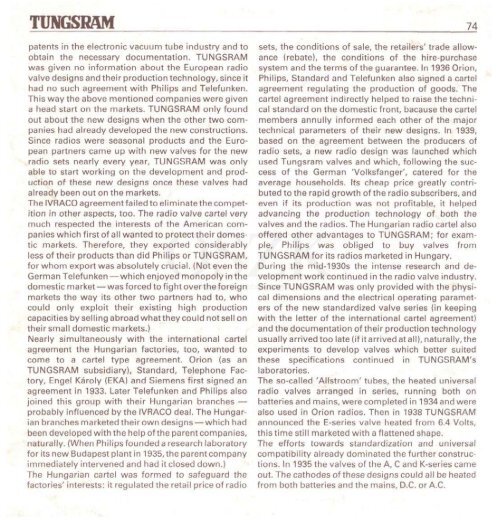THE HISTORY OF TUNGSRAM 1896-1945 - MEK
THE HISTORY OF TUNGSRAM 1896-1945 - MEK
THE HISTORY OF TUNGSRAM 1896-1945 - MEK
- No tags were found...
Create successful ePaper yourself
Turn your PDF publications into a flip-book with our unique Google optimized e-Paper software.
<strong>TUNGSRAM</strong>•.*-VV'74patents in the electronic vacuum tube industry and toobtain the necessary documentation. <strong>TUNGSRAM</strong>was given no information about the European radiovalve designs and their production technology, since ithad no such agreement with Philips and Telefunken.This way the above mentioned companies were givena head start on the markets. <strong>TUNGSRAM</strong> only foundout about the new designs when the other two companieshad already developed the new constructions.Since radios were seasonal products and the Europeanpartners came up with new valves for the newradio sets nearly every year, <strong>TUNGSRAM</strong> was onlyable to start working on the development and productionof these new designs once these valves hadalready been out on the markets.The IVRACO agreementfailedto eliminatethecompetitionin other aspects, too. The radio valve cartel verymuch respected the interests of the American companieswhich first of all wanted to protect their domesticmarkets. Therefore, they exported considerablyless of their products than did Philips or <strong>TUNGSRAM</strong>,for whom export was absolutely crucial. (Not even theGerman Telefunken — which enjoyed monopoly in thedomestic market — was forced to fight over the foreignmarkets the way its other two partners had to, whocould only exploit their existing high productioncapacities by selling abroad what they could not sell ontheir small domestic markets.)Nearly simultaneously with the international cartelagreement the Hungarian factories, too, wanted tocome to a cartel type agreement. Orion (as an<strong>TUNGSRAM</strong> subsidiary). Standard, Telephone Factory,Engel Karoly (EKA) and Siemens first signed anagreement in 1933. Later Telefunken and Philips alsojoined this group with their Hungarian branches —probably influenced by the IVRACO deal. The Hungarianbranches marketed theirown designs — which hadbeen developed with the help of the parent companies,naturally. (When Philipsfounded a research laboratoryfor its new Budapest plant in 1935, the parent companyimmediately intervened and had it closed down.)The Hungarian cartel was formed to safeguard thefactories' interests: it regulated the retail price of radiosets, the conditions of sale, the retailers' trade allowance(rebate), the conditions of the hire-purchasesystem and the terms of the guarantee. In 1936 Orion,Philips, Standard and Telefunken also signed a cartelagreement regulating the production of goods. Thecartel agreement indirectly helped to raise the technicalstandard on the domestic front, bacause the cartelmembers annully informed each other of the majortechnical parameters of their new designs. In 1939,based on the agreement between the producers ofradio sets, a new radio design was launched whichused Tungsram valves and which, following the successof the German 'Volksfanger', catered for theaverage households. Its cheap price greatly contributedto the rapid growth of the radio subscribers, andeven if its production was not profitable, it helpedadvancing the production technology of both thevalves and the radios. The Hungarian radio cartel alsooffered other advantages to <strong>TUNGSRAM</strong>; for example.Philips was obliged to buy valves from<strong>TUNGSRAM</strong> for its radios marketed in Hungary.During the mid-1930s the intense research and developmentwork continued in the radio valve industry.Since <strong>TUNGSRAM</strong> was only provided with the physicaldimensions and the electrical operating parametersof the new standardized valve series (in keepingwith the letter of the international cartel agreement)and the documentation of their production technologyusually arrived too late (if it arrived at all), naturally, theexperiments to develop valves which better suitedthese specifications continued in <strong>TUNGSRAM</strong>'Slaboratories.The so-called 'Allstroom' tubes, the heated universalradio valves arranged in series, running both onbatteries and mains, were completed in 1934 and werealso used in Orion radios. Then in 1938 <strong>TUNGSRAM</strong>announced the E-series valve heated from 6.4 Volts,this time still marketed with a flattened shape.The efforts towards standardization and universalcompatibility already dominated the further constructions.In 1935 the valves of the A, C and K-series cameout. The cathodes of these designs could all be heatedfrom both batteries and the mains, D.C. or A.C.








![Letöltés egy fájlban [4.3 MB - PDF]](https://img.yumpu.com/50159926/1/180x260/letaltacs-egy-fajlban-43-mb-pdf.jpg?quality=85)







